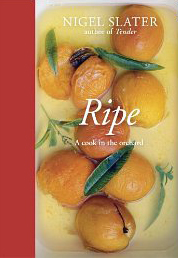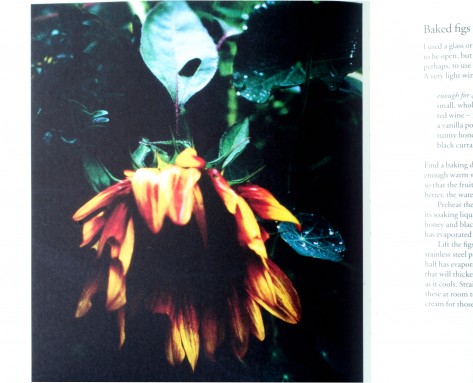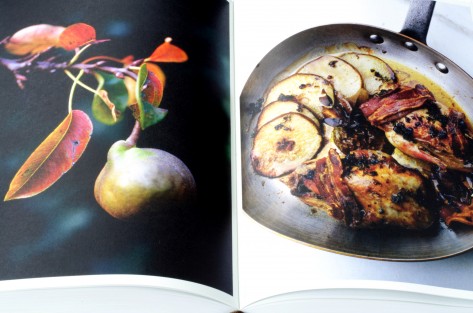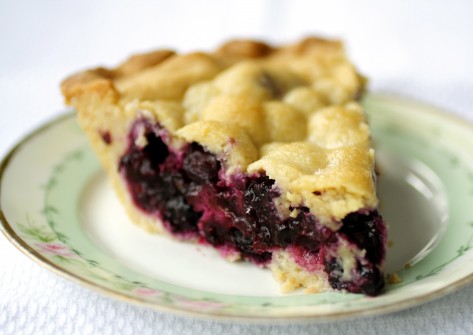The Delights of Gastro-Porn
 RIPE
RIPE
A Cook in the Orchard
by Nigel Slater
Ten Speed Press
591 pp. $40.00
For many, this summer’s read was the phenomenally popular Fifty Shades of Grey by E. L. James, a soft-porn bondage thriller that has, I have it under good authority, led to an increase in sales of rope in hardware stores.
I got my kicks from reading Ripe by Nigel Slater, a deliciously written bit of fruit-focused gastro-porn disguised as a cookbook.
In two notable, particularly “hard-core” examples, Slater’s descriptions of his encounters with the fruits of his London garden allude to oral sex and S & M.
Of the peach, stating why he prefers it to the nectarine, he writes:
. . . the feel of the peach’s soft fuzz on first my upper and then my lower lip, the way the skin puckers as I bite, a teasing prelude to the sweet flesh that will follow. And all of this before the juice—sweet, cool, and sensuous—even touches my tongue.
And of the raspberry:
I can clearly remember the moment I fell totally, hopelessly in love with the scarlet berries. It is seven or maybe eight o’clock one morning in October, the garden is somber with mist, and the heavy air is damp and fungal. The raspberry canes have fallen across the path through want of a stick. I lift them to pass. Hanging down from the canes are crisp brown leaves and bunches of berries, some rotting, others about to collapse, their beads heavy with arterial-red juice. I pick them and they are so soft they break in my fingers, sending beads of red juice down my hand. I eat what I can and lick the rest from my skin. The single leaf by which I am holding the branch tears and the cane crashes back, its sharp thorns scratching my arm, leaving a long gash with little blood dots here and there along its length. I run my tongue along the scratch, then I go back indoors.
Most of Slater’s writing, however, is soft gastro-porn: sensual, reverential descriptions of the pleasures of seeing, smelling, and touching the bushes and trees in his London garden and the beautiful blossoms and fruit they produce, the latter of which, and sometimes the former (Slater loves working with the elderflower) is transformed in his kitchen, with as light a hand as possible, into delights of the table.
If in Art Appreciation class you found the Romantics over the top, you may find Slater’s writing flowery. I find it something to savor, just as Slater savors the fruits he loves so dearly. I fell into a meditative, morning routine: with book in hand, while comfortably catching a summer breeze on my front porch, I imagined pleasures with quinces, gooseberries, and damson plums. Eventually, I moved indoors to the kitchen to sample some of Slater’s fruit-forward recipes, using our own black currants and blueberries from Dowdy Corners.
It was Marianne, one of the newest members in this book club, who pointed out just how romantic Ripe is—from Jonathan Lovekin’s moody, painterly photographs to Slater’s tender descriptions of and nostalgic longings for the fruits of his youth, specimens that hadn’t been bred for shipping qualities but rather for taste, and finally to the book itself, its classic-looking typography and very pretty ligatures, its satisfyingly thick matte ivory paper, real cloth binding, and useful satin book ribbon. Marianne commented that some of the plates and bowls used in the photographs looked as if they’ve been dug up from a French Revolutionary archaeological site, with layers of nostalgic dirt still attached.
In Lovekin’s gum bichromate−like garden photographs, the fruits and blossoms emerge from darkness, from the dank and mysterious world of nature (and all this from a small urban garden). The food photographs, nearly but not always as sensuous, are generally more brightly lit, set in a sunlit kitchen of weights and measures. Some of the most striking spreads of the book show facing fruit and recipe photos, one in the half shadows, the other in light that allows us to clearly see what we are eating.

One of Jonathan Lovekin’s gorgeous photographs in the fig chapter in RIPE. (Note: I shot this from the book to give you an idea of Lovekin’s photography, but have done it some disservice in the process. For a better look at his work, pick up a copy of the book.)

A spread from the Pear chapter in RIPE, showing some of Jonathan Lovekin’s beautiful photographs. (Note: I shot this from the book to give you an idea of Lovekin’s photography, but have done it some disservice in the process. For a better look at his work, pick up a copy of the book.)
But Slater is not all romantic reverie. He is educational as well. He taught me to sprinkle some water over an oat and ground almond topping to create “a delightful assortment of textures” for a black currant crumble and to leave a few apricot pits in when making apricot compote or jam (the pits’ faint almond notes add nuanced flavor). I learned that black currants freeze well (a useful tip to know when picking small amounts from your bushes, as I did before leaving Dowdy Corners), and that if ever stay long enough in one place to have a pear tree that bears fruit, I should pick the pears before they ripen. If left on the tree, they will turn gritty, a result of the sugar crystals turning to starch.

Top: Frozen black currants tossed in sugar before baking; bottom: Black currants under an oat and almond crust
I also learned how war and taxes affects the fortune of fruits. In Britain during WWII, sugar rationing led to a sharp decline in consumption of the damson plum, a kitchen fruit that requires sugar to be edible, leading to the destruction of many ancient orchards. Conversely, in the late 1800s when the sugar tax was abolished, gooseberries, another fruit that requires sugar, was popular as never before, or since.
But what of the food in Ripe? It is a recipe book after all. Everything I and other club members tried was universally liked, with a few minor exceptions. (More on that in a minute.) Our potluck consisted of the Celery Root and grape salad; A salad of peaches, mozzarella, and basil; Crisp pork belly with sweet peach salsa; a rice pudding to show off a fruit compote; Baked peaches with maple syrup and vanilla; Blueberry fool; and Blueberry batter pudding.
The food was deliciously under wrought; small, elegant flourishes nudged the flavor of the ingredients forward. Tamara, one of our club members, who has described herself as being lifelong blueberry hater, was converted to a fan of the berry after trying the fool and pudding.
None of the recipes are difficult. Their simplicity was initially a source of complaint for some members in the group. There wasn’t enough that to do in the kitchen—no inspiring challenges, no recipes that required hours of prep or cooking. A funny complaint in our bland, white-washed days of “fast-and-easy” recipe collections.
Slater admits this is a “problem” for him as well because he, like anyone interested in participating in a cookbook club, enjoys cooking and doesn’t mind spending an entire day making one fabulous dish. In general, however, the less we do to fruit, the better, and this philosophy is what guided Slater in the development of his recipes.
Some of the fruit preparations are suggestions rather than recipes. Easily overlooked, they are not to be missed. Look for descriptions of ingredient pairings found at the end of the introductory text about each fruit.
I found this description from the food pairing list “Raspberries and . . .” particularly intriguing:
Champagne Drop a couple of drippingly ripe ones into each glass, or put one or two berries on your tongue between each mouthful of wine, as if you were popping pills.
What was the main complaint about the recipes, besides not being a “cook’s cookbook”? A couple of members who have done more baking than me spotted problems with the pastry recipes. Unlike American recipes for pie pastry, no water is used; Bhakti, a new club member, made Little fig and blackberry pies and had difficulty bringing this very dry pastry dough together. I liked the result, which I thought was pleasingly soft; Bhakti, perhaps in the mood for wonderfully flaky pie crust, did not care for it.
Over Labor Day weekend I made one final recipe using fresh blueberries; it’s the end of the season here. I tried Slater’s recipe for Blueberry pie, which is even less like an American pie pastry recipe than the recipe Bhakti had made. First, butter and sugar is creamed. Egg is added, and then the dry ingredients. It is lightly kneaded, then rolled into rounds.
Is this sort of cake/pie pastry method, and Slater’s predilection for a very short, very soft pastry a British thing, or a Slater thing? (Nigel, are you out there?) I don’t know. All I know is that the combination of his tart filling of blueberries, lemon juice, and red currant jelly and sweet, soft dough is impossibly good.

Blueberry pie from RIPE (my new favorite recipe)
* * * * * * * * * * * * * * * * * * * * * * * * * * * * * * * * * * * * * * * *
More notes about Slater and Ripe:
He doesn’t specify unsalted or salted butter in his pastry recipes. When I made his blueberry pie, I used unsalted butter and added a generous pinch of fine-grained sea salt.
He likes cats, or at least cat metaphors. I leave it to you to read Ripe and discover how a cat can have anything to do with black currants (page 135), quinces (page 433) and medlars (page 570).
Tender (vol. II), the British name for Ripe, is perhaps the better title. It describes not only Slater’s relationship with the fruits about which he writes, but also the condition of many fruits when perfectly ripe and at the moment of greatest eating pleasure, before tipping over to the other side.
If you make Slater’s blueberry pie (page 161 in Ripe), eat it up the day of or after making it; by the third day, the soft bottom crust begins to get a little soggy, though it’s still delicious.

Great review, loved the tie in with Shades of Grey. I didn’t buy any rope but believe I purchased more fruit! Like you I got my “kicks” from this excellent cookbook.
1Here’s to the power of tender, ripe, and juicy fruit to liven up our kitchens . . .
2